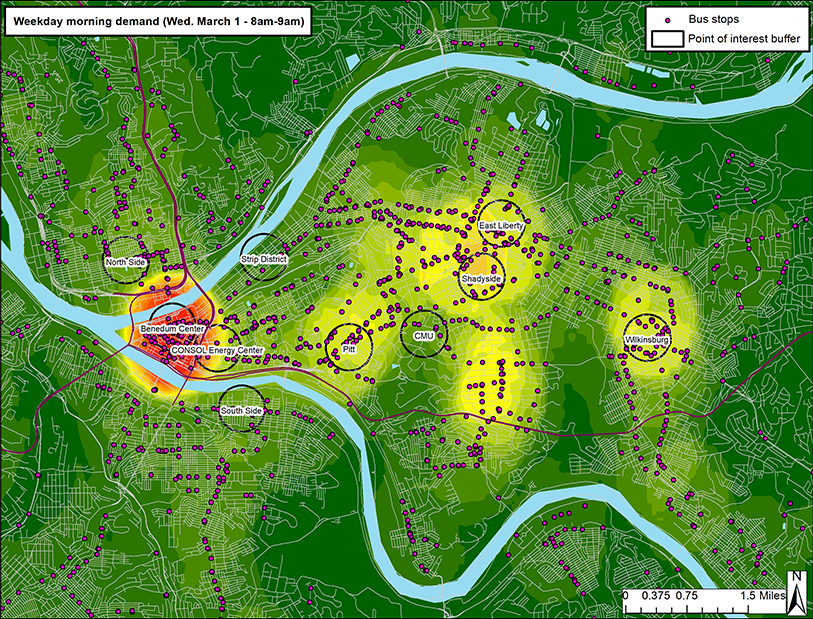Quantifying transportation relationships
Sean Qian studied the relationship between Uber and public transportation, proving it can vary by time of day and location.
In our modern world, it’s easy to get across town. With companies such as Uber and Lyft, known as transportation network companies (TNC), passengers have plenty of options on how they will travel. Both TNCs and public transportation leaders rely on data to influence their policies, so Sean Qian, associate professor of civil and environmental engineering, set out to study the relationship between TNCs and public transportation in Pittsburgh. In a recently published paper in Transportation, Qian’s Mobility Data Analytics Center focused on whether consumers were substituting public transit with TNCs, making last-minute decisions to choose a TNC over public transportation based on fares.
TNCs and public transportation can have a complementary relationship—that is, the TNC helps fill service gaps in public transportation. It is impossible for buses, subways, and light rails to easily connect every single street, but TNCs can cover the first and last portion of the trip. Between public transportation and short TNC rides, consumer costs can be kept to a minimum, while maximizing accessibility to the community.
However, according to CMU Ph.D. student Rick Grahn, it can be difficult to understand the relationship between TNCs and public transportation; sometimes there may be no relationship at all.
The main thing this research is showing is that it is important to look throughout the day and at all these neighborhoods with different characteristics.
Rick Grahn, Ph.D. student, CEE
“Some of the current literature says bus riders are quite different from people who would use Uber, so maybe there’s not a lot of interaction between the two,” Grahn said. “It’s hard to make any definitive conclusion of what drives travelers’ choices are and how those choices may vary from time to time, and from location to location.”
Researchers can look at the bus ridership before and after TNCs begin servicing an area, but changes may not be directly related to the TNC, making it almost impossible to tell why bus ridership changed. The best way to learn about the relationship between TNCs and public transportation is to analyze trip-level data, but such data can be difficult for researchers to access.
To acquire trip-level-like information, Qian and his team used Port Authority data that counts how many people board passing buses and tracked Uber prices at 10 different hand-picked locations around Pittsburgh. Busier locations were preferred, and each needed to be isolated from the other locations. There are many variables that decide if a person takes the bus or a TNC, so Qian accounted for the weather, nearby events, traffic, and other bus stops. To smooth out daily inconsistencies, data was taken over a six-month period.
Qian was most interested in learning what an increase, or surge, in TNC prices does to bus ridership. Surge pricing works by comparing how many drivers are in an area with how many people need rides. If there are more riders than drivers, prices go up. Otherwise, it falls back to a pre-set rate.
Since an increase in TNC riders results in an increase in price, it might seem natural that bus ridership would increase during these surges. However, that doesn’t always seem to be the case.

Source: College of Engineering
Heat map showing morning bus demand. More demand shown in redder regions.
At stops on a university campus, which were filled with students, this assumption held. Qian states that this is probably related to the notoriously low student budget and the fact that Carnegie Mellon and University of Pittsburgh students have unlimited public transportation use incorporated into their tuition. However, at locations that connected local buses and downtown along a dedicated busway, there was a decrease in bus boarding, suggesting a substitutional relationship between TNC and public transportation. This might also indicate that TNCs are providing last-mile services to passengers using the dedicated busway. Otherwise, no correlation was found between price surges and bus boarding.
While these results may be unique to Pittsburgh, researchers can apply the same model to other cities to find relationships there. According to Grahn, once the relationship is understood, targeted policies can be applied at a neighborhood level, ensuring a complementary and efficient relationship between transportation options.
“Congestion fees can be applied to TNC trips in specific congested areas during commute times to promote more space efficient modes of travel,” Qian and his co-authors conclude. “Data-informed policies that consider emerging modes of travel are central to limiting rising congestion costs and improving mobility for vulnerable populations.”
At the locations where significant changes in bus ridership occurred, the trend was restricted to specific times of the day and either weekdays or weekends. This fact alone is important, according to Qian. Large macroscopic research may not yield the significant, small-scale trends his team found.
“The main thing this research is showing is that it is important to look throughout the day and at all these neighborhoods with different characteristics,” Grahn said.
